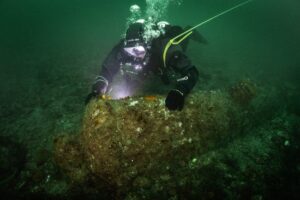The Mediterranean lobster, Palinurus elephas, was named after the Roman seaport of Palinurus, known today as Palinuro, in southwestern Italy, where it was found in abundance in ancient times. Besides the Mediterranean Sea, this lobster can also be found in the Atlantic, all the way from the northwest African coast to Norway in the north. They are common on the shores of Ireland and Britain, where they are called crayfish and crawfish.
Mediterranean lobsters are the real couch potatoes of the sea. They live on rocky bottoms, up to 200m below the surface, and spend most of their days in small caves or rock crevices. Most of them are solitary but can be found to live in pairs and small groups. These lobsters only leave their caves at night, usually to find something to eat. This can be a rare sight, as they are famous for being able to survive up to a week without food. Once they do decide to go out for dinner, it’s an ‘all you can eat bottom of the sea buffet’ for the Mediterranean lobster. They won’t oppose a meal of mollusks, sea stars, algae, sea worms, or other crustaceans.
Since there are few social events for Mediterranean lobsters, females must make the first move once they are out at night on the sea bottom. Similarly to crickets on land, they call out for males by rubbing the bases of their antennae to make a sound, a move called “stridulating” in the animal world, however, humans can not hear these love songs, as the sounds produced are 20-55 kHz, in the ultrasonic range, beyond our hearing. Males can hear this call from 15-20 meters away and rush to meet their mates. Once courtship is done, females can carry fertilized eggs for up to nine months. Eggs are usually hatched into leaf-shaped larvae at the beginning of spring.
Growing up as a Mediterranean lobster is quite turbulent and stressful, as the larvae must go through 10 phases of plankton-dwelling life forms before turning into puerulus larvae, which can actively swim and ultimately develop into a full adults.
Written by Lena Ilic, B.Sc., Marine Biologist
Photos by Janez Kranjc and Ivana OK
The post The Mediterranean lobster appeared first on Mares – Scuba Diving Blog.
Read MoreDiving, biodiversity, lobster, marine life, Mediterranean, sea creaturesMares – Scuba Diving Blog

